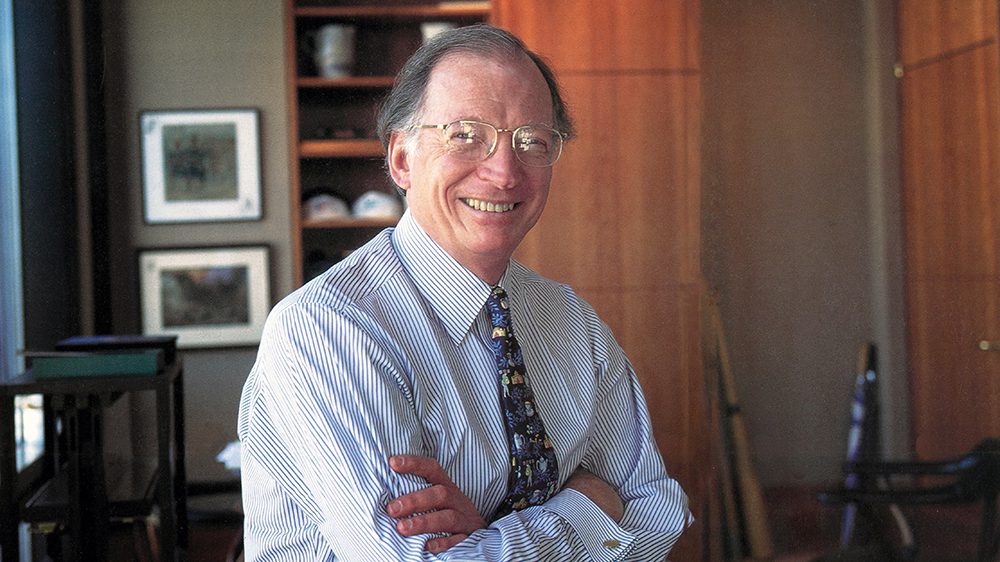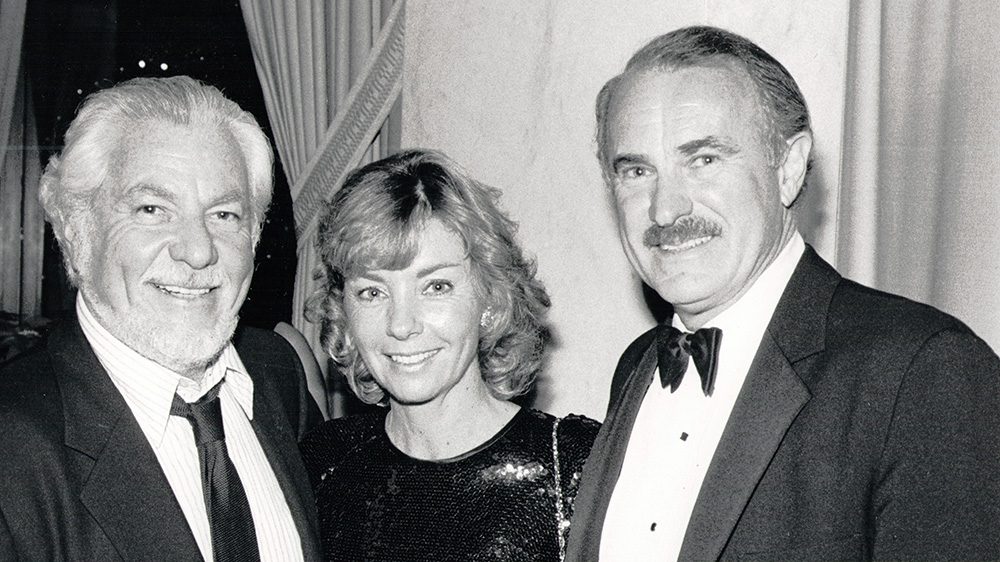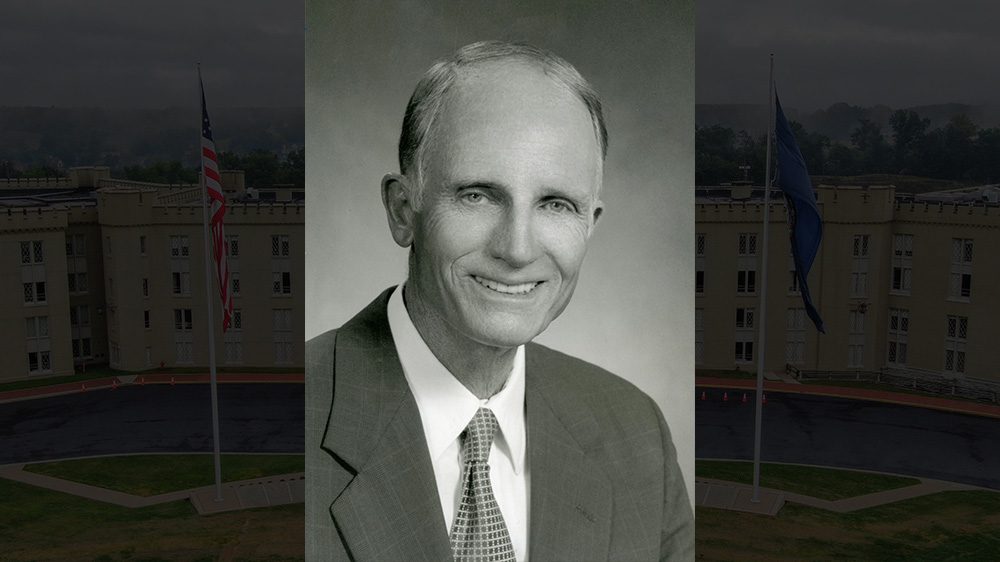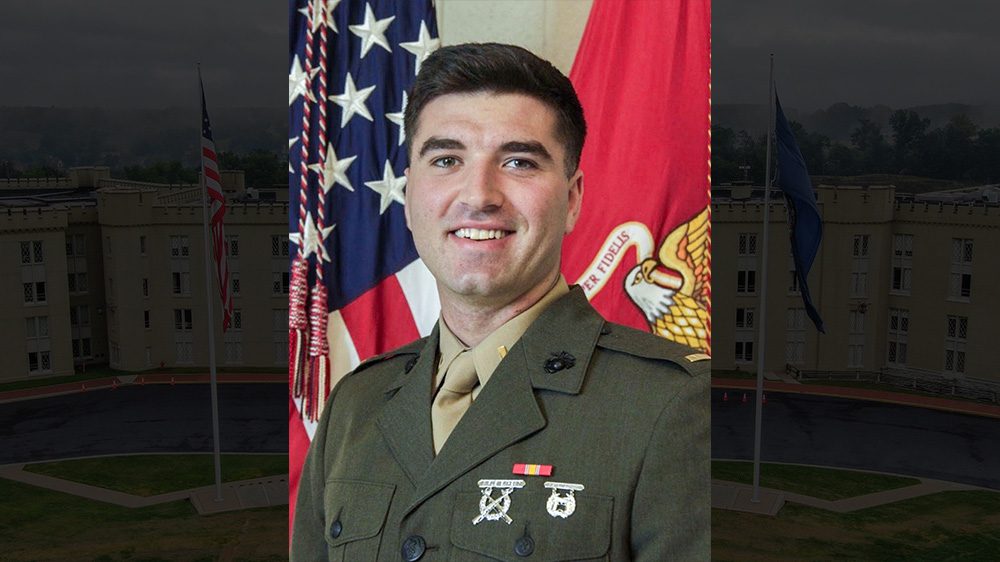Thomas A. Saunders III ’58, who was a vice president of the VMI Board of Visitors, longtime volunteer leader, and generous donor in support of VMI, died Sept. 9, 2022, at his home in Palm Beach, Florida. He was 86. Former President George W. Bush awarded him and his wife, Jordan, the National Humanities Medal in 2008. Considerable achievement at the highest levels of finance and business marked Saunders’ life, as did selfless service in the fields of public policy and philanthropy, especially as it related to higher education, the arts, and historical preservation.
Hailing from Ivor, Virginia, Saunders majored in electrical engineering and was a distinguished military graduate of VMI. He participated in intramural athletics all four years of his cadetship, and he engaged in several activities, including the American Institute of Electrical Engineering, the Tidewater Club, the Canterbury Club, rat basketball, the Glee Club, and his class’ Ring Figure Committee.
In an article in the Fall 1985 edition of the VMI Alumni Review, Col. Lee Nichols ’44 described Saunders, who finished third among electrical engineering majors in his class, as a cadet. He was, said Nichols, “smart, articulate, and very wild. He was boisterous, had great leadership potential, was a total nonconformist, and [was] a real maverick. He was a challenge in the classroom. I suspect that he was a real party man.” Whoever wrote his history in The Bomb was prescient, predicting, “Everyone knows that whatever he may do … and wherever he may go, Tommy will be a success and keep the party going in his ‘wonderful little way.’”
After graduation, Saunders worked from 1959–62 for C.E. “Pete” Thurston, Class of 1935, in the distribution of industrial products. He then joined the industrial division of Allis-Chalmers Manufacturing Company, a leading producer of heavy machinery for various industries, in 1962, and transferred to its space and defense sciences in 1964. In the latter position, he worked on the research and development of fuel cells for various government projects, including NASA’s Apollo program and the Air Force’s Manned Orbital Laboratory program. A citizen-soldier in the best VMI tradition, Saunders served as an infantry officer in the U.S. Army Reserve from 1958–64, achieving the rank of captain.
His life took a dramatically new direction when he received a scholarship to the University of Virginia’s Colgate W. Darden Graduate School of Business in 1964. Immediately after he graduated with a Master of Business Administration degree in 1967, he left Virginia for New York City and the investment banking firm Morgan Stanley, where he would work for the next 22 years.
In 1974, after working in corporate finance and marketing, he became the manager of its syndicate department; the same year, he became a partner and managing director. He received the additional duty of heading the company’s Capital Market Services Group in 1981. His 1974 promotion coincided with the beginning of one of the most dynamic and innovative periods on Wall Street and throughout global finance, and Saunders played a leadership role in many significant transactions of the time. In 1980, for example, he managed Apple Computer’s initial public offering. He was instrumental in guiding AT&T during its $150 billion divestiture of the Bell System in 1984, the largest restructuring in U.S. corporate history. The next year, he organized the investors who purchased the freight railroad Conrail for $1.6 billion when the U.S. government privatized it. Saunders did not limit his involvement to deals in the United States. In the mid-1980s, he headed the U.S. financial advisory effort to the British government’s privatization of British Telecom and British Petroleum. Saunders later became chairman of Morgan Stanley’s $2.2 billion leveraged buyout fund.
In 1990, Saunders began to apply his talents to the field of private equity, founding the firm Saunders Karp & Megrue, which merged in 2005 with Apax Partners, LP, a London-based private equity firm. During the next dozen years, his firm served many customers, including AT&T, General Electric, United Technologies, and the University of Texas. It also invested in numerous companies, including Hibbett Sports and Dollar Tree, Inc. Saunders was on the board of both corporations for nearly three decades and served many years as lead director of Dollar Tree. Starting in 2002, Saunders was the chief executive officer of Ivor & Company, LLC, and the president of the Ivor Foundation, a family investment firm and family foundation, respectively, positions he held until his death.
Despite an exceptionally demanding professional career, he participated in many organizations devoted to higher education, historic preservation, public policy, and the arts. His passion for art led him to acquire European Old Masters paintings, some of which he loaned for exhibition to major museums, including the National Gallery of Ireland and the Museum of Fine Arts in Boston. More than 80 works from what is known as the Jordan and Thomas A. Saunders III Collection are on loan to the Virginia Museum of Fine Arts in Richmond, Virginia, and form the ongoing exhibit, “Elegance and Wonder.” He also served on the Trustees’ Council of the National Gallery of Art in Washington, D.C., and as trustee of the Norton Museum of Art in Palm Beach, Florida.
“Don’t shy away from change or opportunity. There are always risks involved in pushing yourself in this manner, but you will never know the extent of your abilities until tested on the firing line.”
Thomas A. Saunders III '58, at the Class of 1980 ring presentation ceremony
Always intensely interested in the history of the United States and immensely proud of his ancestors who had settled in Virginia in the 17th century, Saunders was a member of the Board of Trustees of the Thomas Jefferson Foundation from 1997–2008 and served as its chairman from 2002–08. Under his leadership—and with his philanthropic support—the Thomas Jefferson Foundation established several new positions and programs, including the publication of the Papers of Thomas Jefferson: Retirement Series, of which 18 volumes are now in print. Saunders’ support brought several infrastructure projects, such as the Thomas Jefferson Parkway, to completion and helped the foundation purchase Montalto, the mountain adjacent to and overlooking Monticello. The foundation honored Saunders’s service by naming a hiking trail and a bridge for him in 2002. Saunders was also a board member of the New York Historical Society and received its 2007 History Makers Award.
From 2005–18, Saunders was on the board of The Heritage Foundation, one of the country’s most influential conservative think tanks, and served as its chairman 2008–18. In the latter role, he led in establishing its policy advocacy arm, Heritage Action for America. He received the organization’s highest honor, the Claire Boothe Luce Award, in 2018. In a statement released soon after Saunders’ death, Heritage praised him, saying his “love of country, his desire to build an America that offered all her citizens freedom, opportunity, and the chance to flourish, made him the perfect leader for Heritage.”
Saunders’ enduring interest in education was evident in his service to and support of the Marine Corps University Foundation, the University of Virginia, and VMI. He was a member of the board of MCUF, and he and his wife endowed the Major General Matthew C. Horner Chair in Military Theory in honor of Jordan’s father. At UVA, Saunders was chairman of the board of the Darden School Foundation and the university’s board of visitors. When he was a member of the university’s board, he led the transformation of the management of the school’s endowment, which led to the creation of an independent management company. From 1995–2000, he was the national co-chairman of the University of Virginia’s $1.4 billion capital campaign.
Devoted to the advancement of the Institute, Saunders served in many ways. In 1978, for example, he was the speaker at the Class of 1980’s ring presentation ceremony. The main thrust of his remarks was “some of the traits … you should work on if you want to enhance your chances for success and for becoming a leader in our society.” He offered 12 of them, and all of them are sound advice; however, the final one stands out: “The best way to stretch yourself intellectually and develop professionally is to seek the difficult task,” said Saunders. “Don’t shy away from change or opportunity. There are always risks involved in pushing yourself in this manner, but you will never know the extent of your abilities until tested on the firing line.”
Saunders was the chairman of the fund drive his class conducted in conjunction with its 25th Reunion in 1983. He served as a trustee of the VMI Foundation from 1980–87 and again from 1990–93. He joined the VMI Board of Visitors in 1993 and served for a total of eight years, becoming one of its vice presidents in 1997. At the time of his death, Saunders was one of the longest-serving members of the Jackson-Hope Fund’s Board of Overseers, which he joined in 2000. From 1998–2004, Saunders was a member of the executive committee of the fundraising campaign, Reveille: A Call to Excel, which raised $205.9 million in gifts and commitments. Saunders and Jordan also planned and oversaw the execution of the Parade Ground Dinner in 2000, the unparalleled event on post that marked the opening of Reveille’s public phase. He was an inaugural member of the board of the General J.H. Binford Peay III 1962 Endowment for Academic Excellence. In all these positions, he applied what he had learned through his experiences in global business and finance with an eye toward ensuring VMI had a secure place among the best colleges and universities in the U.S.
Saunders was also a consistent and exceptionally generous donor to VMI. For example, the $20 million commitment he and his wife made at the outset of the Reveille campaign stands as one of the largest individual gifts ever received by VMI. While he gave to many activities at VMI, such as scholarships and the Center for Leadership and Ethics, he directed most of his philanthropy to the academic program, most recently to the Peay Endowment. In a 2020 letter acknowledging a gift from Saunders, most of which he directed to that endowment, Peay praised his contributions to VMI’s academic progress, “Your long-standing commitment to the improvement of the Institute’s academic program has been critical to the strides it has made in the past two decades. This support, along with your continued service on the Jackson-Hope Board of Overseers and the board of the Peay Endowment, will have an enduring impact on the Institute’s ability to graduate honorable, purposeful, and well-educated citizen-soldiers.”
In 2000, Saunders responded to a question about the source of his devotion to the Institute’s advancement by saying, “In 1839, Francis H. Smith had the vision to produce leaders for Virginia and the nation. He succeeded beyond his grandest dreams. Then, the Institute’s destiny was in his hands; today, it is in our hands.”
In recognition of his professional achievements, active citizenship, and devoted service to VMI, the VMI Foundation presented its distinguished service award to Saunders in 2004. The citation for the award described him as “a tireless advocate of VMI’s singular education and an ardent supporter of efforts to advance VMI’s academic program” and as someone who “provided an inspiring example of dedication to the Institute.”
Saunders is survived by his wife of 61 years, Mary Jordan Horner Saunders, and his daughter, Mariah Calvert Claud Saunders Moore, and son-in-law, George Braniff Moore, as well as their three children, Rebecca Carter Saunders Moore, George Saunders Van Rensselaer Moore, and Mary Schuyler Jordan Moore. He is also survived by his son, Thomas A. Saunders IV, and grandson, Thomas A. Saunders V.
Members of the VMI family may make memorial gifts in Saunders’ honor to the General J.H. Binford Peay III 1962 Endowment for Academic Excellence at VMI.
-
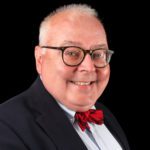
Scott Belliveau '83 Communications Officer - Executive Projects
The communications officer supports the strategy for all communications, including web content, public relations messages and collateral pieces in order to articulate and promote the mission of the VMI Alumni Agencies and promote philanthropy among varied constituencies.

